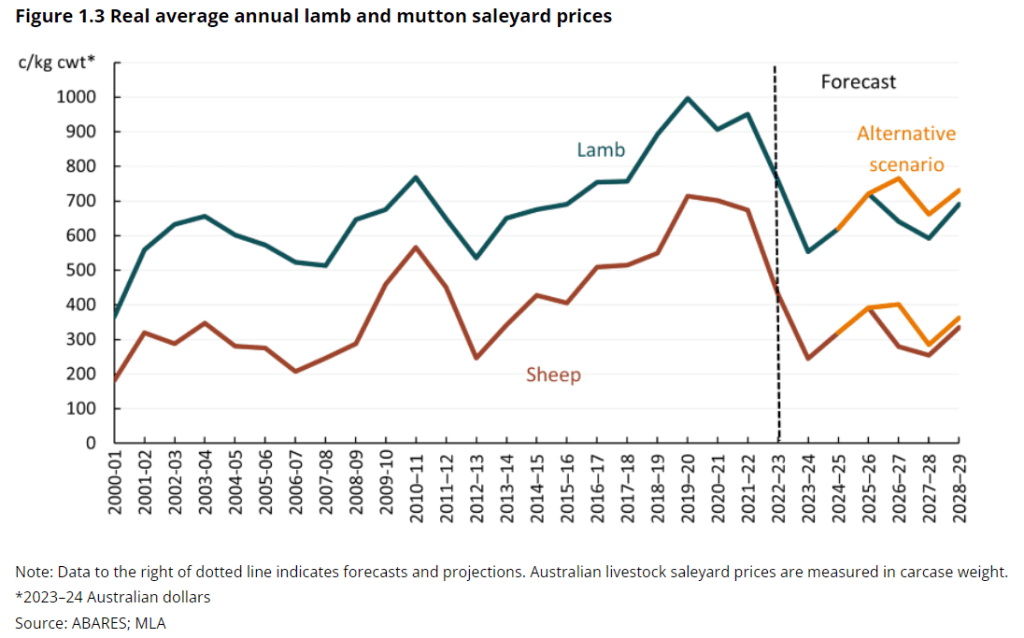
AVERAGE saleyard sheep and lamb prices in 2023-24 are expected to be lower than in 2022-23, but rise in 2024-25, the latest ABARES Agricultural Conmmodities report has concluded.
Reflecting higher turn-off rates and lower restocker demand, the report released this week said lamb saleyard prices are expected to average 553 cents per kilogram (carcase weight), down by 24 percent from 730c/kg in 2022-23.
Sheep saleyard prices are expected to average 245c/kg cwt, down by 41pc from 415c/kg in 2022-23.
ABARES said the onset of both El Niño and a positive Indian Ocean Dipole have led to drier seasonal conditions across Australia and these climatic drivers led to below average rainfall and above average temperatures across Australia over 2023–24, prompting higher turn-off rates and lower restocker demand.
In 2024-25, ABARES expects sheep prices to rise due to a decreased supply of sheep for slaughter and greater saleyard demand from both restockers and processors.
“Improving seasonal conditions relative to 2023–24 are expected to increase pasture availability and soil moisture levels.
“This is expected to improve farm demand for breeding livestock, decrease turn-off rates and increase saleyard prices,” the report said.
“Stronger US demand is also expected to support saleyard processor demand, driving up saleyard prices.
“Nominal lamb saleyard prices are forecast to increase to 640 cents per kilogram, while sheep saleyard prices are forecast to rise to 329 cents per kilogram.”
ABARES said over the outlook period, real sheep and lamb saleyard prices are expected to fluctuate, sensitive to the impact of seasonal conditions on the Australian sheep flock (Figure 1.3).
“Prices are expected to rise in years with wetter conditions, as favourable pasture growth and improved outlook for feed availability incentivise flock rebuilding.
“Conversely, higher turn-off is expected in years with less favourable conditions, which should put downward pressure on prices.”
ABARES said real sheep saleyard prices are expected to range between 254 and 335 cents per kilogram. Real lamb saleyard prices are expected to range between 592 and 690 cents per kilogram.
In an alternative scenario, ABARES said real average saleyard prices are projected to be higher than the baseline scenario (Figure 1.3).
“Wetter seasonal conditions, if realised, are projected to lead to stronger flock rebuilding, placing upwards pressure on saleyard prices; this reflects increased demand for restocker livestock and reduced supply as producers retain their breeding ewes.”
Rebound predicted for Australian agriculture
ABARES said Australia’s farm, fisheries and forestry sectors are set to rebound in 2024-25, with the latest Agricultural Commodities and Australian Crop reports predicting that the gross value of production in 2024–25 will again increase after poor seasonal conditions affected outcomes in 2023-24.
Executive director of ABARES Dr Jared Greenville said a rebound of up to 6pc is predicted, bringing the gross value of Australian farms, fisheries and forestry to $90.8 billion, the third highest on record.
“The gross value of Australian crops production, as well as livestock and livestock products, are both estimated to increase to $48.7 billion and $36.2 billion respectively.
“For our livestock production and livestock products industries this is a record high and the result of expected favourable climate conditions and improving prices,” he said.
“Above-average summer 2023–24 rainfall and subsequent build-up of soil moisture reserves in eastern Australia is expected to provide a good incentive for planting ahead of the 2024–25 winter crop season.
“Broadacre farm cash incomes are also set to rebound in 2024-25 to $192,000, after significant falls in 2023-24,” he said.
“The forecast improved growing season climate conditions and the expected turnaround in livestock prices in 2024–25 will drive increases in farm income.”
Dr Greenville said in 2023-24, the value of Australia’s agriculture, fisheries and forestry exports is forecast to fall by 13pc to $71.6 billion, but this follows the record high the industry experienced the previous year.
“This decline is expected to continue, with an additional 5pc decline expected, leaving the 2024-25 value at $68.1 billion.”
The most recent Agricultural Commodities Report can be read on the ABARES website: Agricultural commodities – DAFF (agriculture.gov.au)
The Australian Crop Report can be read on the ABARES website: Australian Crop Report – DAFF (agriculture.gov.au)

HAVE YOUR SAY